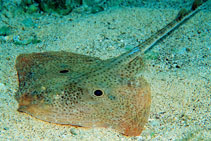http://www.fishbase.org/Summary/speciesSummary.php?genusname=Raja&speciesname=miraletus ---> http://192.134.151.83/Summary/speciesSummary.php?genusname=Raja&speciesname=miraletus
http://192.134.151.83/Summary/speciesSummary.php?genusname=Raja&speciesname=miraletus ---> https://fishbase.mnhn.fr/Summary/speciesSummary.php?genusname=Raja&speciesname=miraletus
https://fishbase.mnhn.fr/Summary/speciesSummary.php?genusname=Raja&speciesname=miraletus ---> https://fishbase.mnhn.fr/summary/Raja-miraletus.html
Raja miraletus, Brown ray : fisheries, gamefish

You can
sponsor
this page
Common name (e.g. trout)
Genus + Species (e.g. Gadus morhua)
-

-
About this page
-
Languages
-
User feedbacks
-
Citation
-
Uploads
-
Related species
-


 Brown ray
Add your observation in
Fish Watcher
Upload your
photos
and
videos
Brown ray
Add your observation in
Fish Watcher
Upload your
photos
and
videos
Pictures
|
Google image
 Raja miraletus
Raja miraletus
Picture by
Furlan, B.
Elasmobranchii (sharks and rays) >
Rajiformes
(Skates and rays) >
Rajidae
(Skates)
Etymology:
Raja:
Latin, raja, -ae = a sting ray (Raja sp.) (Ref.
45335
)
.
More on author:
Linnaeus
.
Environment: milieu / climate zone / depth range / distribution range
Ecology
Marine; brackish; demersal; depth range 17 - 462 m (Ref.
56504
), usually 50 - 150 m (Ref.
27121
). Subtropical; 44°N - 35°S
Northeast Atlantic: from Spain (Bay of Biscay) to Morocco and Madiera, including the Mediterranean Sea.
Length at first maturity / Size / Weight / Age
Maturity: L
m
?
, range 44 - ? cm
Max length : 63.0 cm TL male/unsexed; (Ref.
39256
); 59.7 cm TL (female); common length : 35.0 cm TL male/unsexed; (Ref.
2683
)
Short description
Morphology
|
Morphometrics
Dorsal
spines
(total): 0;
Anal
spines
: 0;
Anal
soft rays
: 0. Snout short and bluntly pointed; disc angular (Ref.
5578
). Upper surface prickly only in young, nearly smooth in adults, underside smooth (Ref.
3167
). Upper surface ochre to reddish-brown with scattered dark spots, underside white (Ref.
3167
); two bright blue eyespots centered on the pectoral bases (Ref.
5578
); may have a small dark spot on tip of snout (Ref.
2708
).
Found over soft bottoms of the shelf and the uppermost slope (Ref.
5578
). Depth range from 17-300 m, and up to depth of 462 m in the eastern Ionian Sea (Ref.
56504
). Feed on all kinds of benthic animals, also on fish offal (Ref.
5578
). Oviparous. Distinct pairing with embrace. Young may tend to follow large objects, such as their mother (Ref.
205
). Eggs are oblong capsules with stiff pointed horns at the corners deposited in sandy or muddy flats (Ref.
205
). Egg capsules are 4.2-4.6 cm long and 2.7-2.9 cm wide (Ref.
41250
). About 40-72 eggs are lain by an individual in a year (Ref.
41250
). Caught by ski-boat anglers (Ref.
5578
).
Oviparous, paired eggs are laid. Embryos feed solely on yolk (Ref.
50449
). With egg-cases laid from spring to summer (Ref.
3167
). Distinct pairing with embrace. Young may tend to follow large objects, such as their mother (Ref.
205
).
McEachran, J.D. and K.A. Dunn
, 1998. Phylogenetic analysis of skates, a morphologically conservative clade of elasmobranchs (Chondrichthyes: Rajidae). Copeia 1998(2):271-290. (Ref.
27314
)
IUCN Red List Status (Ref.
130435
)
Least Concern (LC)
; Date assessed:
04 January 2019
CITES
Not Evaluated
Not Evaluated
Threat to humans
Harmless
Human uses
Fisheries: commercial; gamefish: yes
FAO - Fisheries:
landings
; Publication:
search
|
FishSource
|
Sea Around Us
More information
Countries
FAO areas
Ecosystems
Occurrences
Introductions
Stocks
Ecology
Diet
Food items
Food consumption
Ration
Common names
Synonyms
Metabolism
Predators
Ecotoxicology
Reproduction
Maturity
Spawning
Spawning aggregation
Fecundity
Eggs
Egg development
Age/Size
Growth
Length-weight
Length-length
Length-frequencies
Morphometrics
Morphology
Larvae
Larval dynamics
Recruitment
Abundance
BRUVS
References
Aquaculture
Aquaculture profile
Strains
Genetics
Electrophoreses
Heritability
Diseases
Processing
Nutrients
Mass conversion
Collaborators
Pictures
Stamps, Coins Misc.
Sounds
Ciguatera
Speed
Swim. type
Gill area
Otoliths
Brains
Vision
Tools
Bio-Quiz
|
E-book
|
Field guide
|
Length-frequency wizard
|
Life-history tool
|
Point map
|
Classification Tree
|
Catch-MSY
|
Special reports
Check for Aquarium maintenance
|
Check for Species Fact Sheets
|
Check for Aquaculture Fact Sheets
Download XML
Summary page
|
Point data
|
Common names
|
Photos
Internet sources
AFORO (otoliths) |
Aquatic Commons
|
BHL
|
Cloffa
|
BOLDSystems
|
Websites from users
|
Check FishWatcher
|
CISTI
|
Catalog of Fishes
:
genus
,
species
|
DiscoverLife
|
ECOTOX
| FAO - Fisheries:
landings
; Publication:
search
|
Faunafri
| Fishipedia |
Fishtrace
| GenBank:
genome
,
nucleotide
| GloBI |
Google Books
|
Google Scholar
|
Google
| IGFA World Record |
MitoFish
|
National databases
|
Otolith Atlas of Taiwan Fishes
|
Public aquariums
|
PubMed
| Reef Life Survey | Socotra Atlas |
Tree of Life
| Wikipedia:
Go
,
Search
| World Records Freshwater Fishing |
Zoobank
|
Zoological Record
Estimates based on models
Preferred temperature (Ref.
123201
): 13.1 - 25.6, mean 17.6 °C (based on 383 cells).
Phylogenetic diversity index (Ref.
82804
): PD
50
= 0.5000 [Uniqueness, from 0.5 = low to 2.0 = high].
Bayesian length-weight: a=0.00182 (0.00152 - 0.00218), b=3.27 (3.23 - 3.31), in cm total length, based on LWR estimates for this species (Ref.
93245
).
Trophic level (Ref.
69278
): 3.7 ±0.6 se; based on diet studies.
Generation time: 5.7 ( na - na) years. Estimated as median ln(3)/K based on 1
growth studies.
Resilience (Ref.
120179
): Low, minimum population doubling time 4.5 - 14 years (Fec assumed to be <100).
Fishing Vulnerability (Ref.
59153
): Moderate to high vulnerability (51 of 100).
Price category (Ref.
80766
):
Medium
.
Nutrients (Ref.
124155
): Calcium = 14.6 [1.8, 262.7] mg/100g; Iron = 0.723 [0.068, 8.569] mg/100g; Protein = 17.4 [14.6, 19.7] %; Omega3 = 0.651 [0.282, 1.514] g/100g; Selenium = 27.2 [5.1, 132.3] μg/100g; VitaminA = 5.9 [0.6, 60.8] μg/100g; Zinc = 0.601 [0.041, 6.724] mg/100g (wet weight);
Back to Search
Random Species
Back to Top
Accessed through:
Not available
FishBase mirror site :
localhost
Page last modified by :
mrius-barile
- 20 July 2016
Fatal error
: Uncaught ArgumentCountError: Too few arguments to function checkEcotox(), 1 passed in /var/www/html/summary/speciessummary.php on line 2304 and exactly 3 expected in /var/www/html/includes/speciessummary.lib.php:2579 Stack trace: #0 /var/www/html/summary/speciessummary.php(2304): checkEcotox() #1 {main} thrown in
/var/www/html/includes/speciessummary.lib.php
on line
2579
|